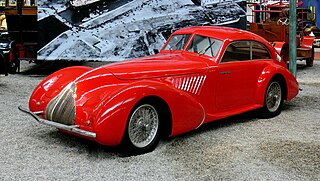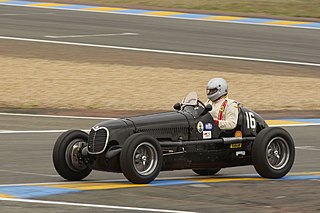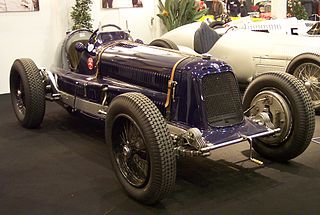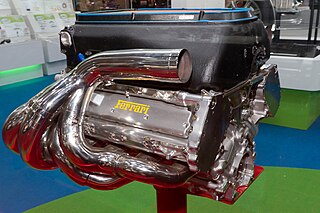
Delage is a French luxury automobile and racecar company founded in 1905 by Louis Delâge in Levallois-Perret near Paris; it was acquired by Delahaye in 1935 and ceased operation in 1953.

English Racing Automobiles (ERA) was a British racing car manufacturer active from 1933 to 1954.

The Alfa Romeo 8C was a range of Alfa Romeo road, race and sports cars of the 1930s.

Itala was a car manufacturer based in Turin, Italy, from 1904 to 1934, started by Matteo Ceirano and five partners in 1903.

The Mercedes-Benz W196 was a Formula One racing car produced by Mercedes-Benz for the 1954 and 1955 F1 seasons. Successor to the W194, in the hands of Juan Manuel Fangio and Stirling Moss it won 9 of 12 races entered and captured the only two world championships in which it competed.

Maserati A6 were a series of grand tourers, racing sports cars and single seaters made by Maserati of Italy between 1947 and 1956. They were named for Alfieri Maserati and for their straight-six engine.

The Maserati Tipo 151 is a racing car manufactured by Italian automobile manufacturer Maserati for the 1962 LeMans season to compete in the experimental GT car class. Three cars were built in total, one for Johnny Simone of Maserati France with a red exterior colour and white tri-stripes whilst two were built for Briggs Cunningham for his racing team. These cars had a white body with two blue stripes.

The Maserati 6CM is an Italian single-seater racing car, made by Maserati of Modena from 1936 to 1940 for the Voiturette racing class. Twenty-seven were built on the Maserati 4CM frame, with front suspension as on the Maserati V8RI, and had a successful racing career from 1936 to 1939. The 6CM was introduced to the world at the 1936 Milan Motor Show. Maserati spent much of its early years manufacturing cars for privateers in the racing field. The Maserati 6CM is no exception.

The Maserati 4CL and its derived sister model the Maserati 4CLT are single-seat open-wheel Grand Prix racing cars that were designed and built by Maserati. The 4CL was introduced at the beginning of the 1939 season, as a rival to the Alfa Romeo 158 and various ERA models in the voiturette class of international Grand Prix motor racing. Although racing ceased during World War II, the 4CL was one of the front running models at the resumption of racing in the late 1940s. Experiments with two-stage supercharging and tubular chassis construction eventually led to the introduction of the revised 4CLT model in 1948. The 4CLT was steadily upgraded and updated over the following two years, resulting in the ultimate 4CLT/50 model, introduced for the inaugural year of the Formula One World Championship in 1950. In the immediate post-war period, and the first two years of the Formula One category, the 4CLT was the car of choice for many privateer entrants, leading to numerous examples being involved in most races during this period.

The Maserati A6GCM is a single seater racing car from the Italian manufacturer Maserati. Developed for Formula Two, 12 cars were built between 1951 and 1953.

The Maserati Tipo 26M was a model of Grand Prix race car produced by Italian manufacturer Maserati in Bologna, for a total of 13 units, between 1930 and 1932.

The Maserati 8CM is a Grand Prix race car produced by Italian manufacturer Maserati in Bologna between 1933 and 1935.

The Maserati Tipo 26B or Maserati Tipo 26B Monoposto was a racing car built by Italian manufacturer Maserati between 1927 and 1930, in a total of six examples and one additional engine.

Ferrari has manufactured three naturally-aspirated V8 racing engines, designed for Formula One racing. First, the Tipo DS50 engine introduced in 1956; with the 2.5 L engine configuration. Second, the Tipo 205/B engine, introduced in 1964; with the 1.5 L engine configuration; and was designed by Franco Rocchi and Angelo Bellei. Then, a 42-year hiatus; until the FIA imposed a 2.4 L engine V8 configuration for all Formula One teams in 2006, with Ferrari introducing their Tipo 056; designed by Gilles Simon.
Maserati has made three inline-4 racing engines, that were designed for both Formula One and Sports car racing. Their first engine was the supercharged 4CLT engine in 1950; with the 1.5 L engine configuration imposed by the FIA for engines with forced induction. Their second engine was the naturally-aspirated 250S engine; with the 2.5 L engine configuration, and was used by Cooper and JBW. Their third and final engine was the naturally-aspirated Tipo 6-1500; with the 1.5 L engine configuration, and the customer engine was used by Cooper, Emeryson, Lotus, and E.N.B. teams.
Maserati made two naturally-aspirated, straight-6, racing engines, designed for Formula One; between 1952 and 1960. The first engine was the 2.0-liter A6G; in accordance with the engine regulations imposed by the FIA. Their second and last engine was the 250 F1; in accordance with the engine regulations imposed by the FIA for 1954. Several of these engines, or derivatives of these engines, were also used in various Maserati sports cars.
Maserati made four naturally-aspirated, V12 racing engines, designed for Formula One, between 1951 and 1969. The first was an experimental O.S.C.A. engine, in accordance with the 4.5 L engine regulations imposed by the FIA for 1951. Their second engine was 250 F1 V12, in accordance with the 2.5 L engine regulations set by the FIA. Their last two V12 engines were customer engines supplied to Cooper, between 1966 and 1969. The Tipo 9 / F1 and Tipo 10 /F1, which were both manufactured to the FIA's 3.0 L engine regulations for 1966. One sports car, a modified version of the Maserati 350S, also used V12 engine, with a 3.5 L (210 cu in) displacement, and produced 335 hp (250 kW).

The Ferrari 166 FL was a single-seat open-wheel race car, designed, developed and built by Italian manufacturer and team, Scuderia Ferrari, 1949 to 1952. Only three cars were produced. The designation 166 refers to the (rounded) displacement of a single cylinder, which corresponded to the nomenclature of the company at the time. The abbreviation FL stands for Formula Libre, which is the type of category and racing series that the car competed in. Since the car was mainly developed for racing in South America, it was also known as the 166 C America.
The Maserati 8CL is an open-wheel Grand Prix motor racing car, designed, developed and built by Italian manufacturer Maserati, from 1940 through 1946. Only two models were produced.

The Maserati Tipo V4 was a grand tourer-style torpedo car, designed, developed, and built by Italian manufacturer Maserati, between 1929 and 1932. It was also notably the first production car to be powered by a V16 engine.

















